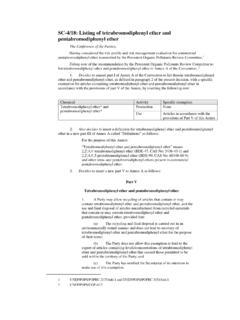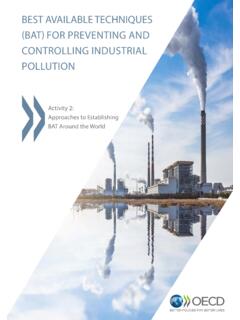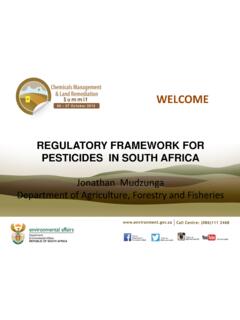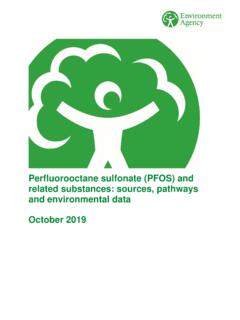Transcription of STOCKHOLM CONVENTION ON PERSISTENT ORGANIC …
1 STOCKHOLM CONVENTION ON PERSISTENT ORGANIC POLLUTANTS The Parties to this CONVENTION , Recognizing that PERSISTENT ORGANIC pollutants possess toxic properties, resist degradation, bioaccumulate and are transported, through air, water and migratory species, across international boundaries and deposited far from their place of release, where they accumulate in terrestrial and aquatic ecosystems, Aware of the health concerns, especially in developing countries, resulting from local exposure to PERSISTENT ORGANIC pollutants, in particular impacts upon women and, through them, upon future generations, Acknowledging that the Arctic ecosystems and indigenous communities are particularly at risk because of the biomagnification of PERSISTENT ORGANIC pollutants and that contamination of their traditional foods is a public health issue, Conscious of the need for global action on PERSISTENT ORGANIC pollutants.
2 Mindful of decision 19/13 C of 7 February 1997 of the Governing Council of the United Nations Environment Programme to initiate international action to protect human health and the environment through measures which will reduce and/or eliminate emissions and discharges of PERSISTENT ORGANIC pollutants, Recalling the pertinent provisions of the relevant international environmental conventions, especially the Rotterdam CONVENTION on the Prior Informed Consent Procedure for Certain Hazardous Chemicals and Pesticides in International Trade, and the Basel CONVENTION on the Control of Transboundary Movements of Hazardous Wastes and their Disposal including the regional agreements developed within the framework of its Article 11, Recalling also the pertinent provisions of the Rio Declaration on Environment and Development and Agenda 21, Acknowledging that precaution underlies the concerns of all the Parties and is embedded within this CONVENTION , Recognizing that this CONVENTION and other international agreements in the field of trade and the environment are mutually supportive, Reaffirming that States have.
3 In accordance with the Charter of the United Nations and the principles of international law, the sovereign right to exploit their own resources pursuant to their own environmental and developmental policies, and the responsibility to ensure that activities within their jurisdiction or control do not cause damage to the environment of other States or of areas beyond the limits of national jurisdiction, Taking into account the circumstances and particular requirements of developing countries, in particular the least developed among them, and countries with economies in transition, especially the need to strengthen their national capabilities for the management of chemicals, including through the transfer of technology, the provision of financial and technical assistance and the promotion of cooperation among the Parties, 2 Taking full account of the Programme of Action for the Sustainable Development of Small Island Developing States, adopted in Barbados on 6 May 1994, Noting the respective capabilities of developed and developing countries, as well as the common but differentiated responsibilities of States as set forth in Principle 7 of the Rio Declaration on Environment and Development.
4 Recognizing the important contribution that the private sector and non-governmental organizations can make to achieving the reduction and/or elimination of emissions and discharges of PERSISTENT ORGANIC pollutants, Underlining the importance of manufacturers of PERSISTENT ORGANIC pollutants taking responsibility for reducing adverse effects caused by their products and for providing information to users, Governments and the public on the hazardous properties of those chemicals, Conscious of the need to take measures to prevent adverse effects caused by PERSISTENT ORGANIC pollutants at all stages of their life cycle, Reaffirming Principle 16 of the Rio Declaration on Environment and Development which states that national authorities should endeavour to promote the internalization of environmental costs and the use of economic instruments, taking into account the approach that the polluter should, in principle, bear the cost of pollution, with due regard to the public interest and without distorting international trade and investment.
5 Encouraging Parties not having regulatory and assessment schemes for pesticides and industrial chemicals to develop such schemes, Recognizing the importance of developing and using environmentally sound alternative processes and chemicals, Determined to protect human health and the environment from the harmful impacts of PERSISTENT ORGANIC pollutants, Have agreed as follows: Article 1 Objective Mindful of the precautionary approach as set forth in Principle 15 of the Rio Declaration on Environment and Development, the objective of this CONVENTION is to protect human health and the environment from PERSISTENT ORGANIC pollutants.
6 Article 2 Definitions For the purposes of this CONVENTION : (a) Party means a State or regional economic integration organization that has consented to be bound by this CONVENTION and for which the CONVENTION is in force; 3 (b) Regional economic integration organization means an organization constituted by sovereign States of a given region to which its member States have transferred competence in respect of matters governed by this CONVENTION and which has been duly authorized, in accordance with its internal procedures, to sign, ratify, accept, approve or accede to this CONVENTION ; (c) Parties present and voting means Parties present and casting an affirmative or negative vote.
7 Article 3 Measures to reduce or eliminate releases from intentional production and use 1. Each Party shall: (a) Prohibit and/or take the legal and administrative measures necessary to eliminate: (i) Its production and use of the chemicals listed in Annex A subject to the provisions of that Annex; and (ii) Its import and export of the chemicals listed in Annex A in accordance with the provisions of paragraph 2; and (b) Restrict its production and use of the chemicals listed in Annex B in accordance with the provisions of that Annex. 2. Each Party shall take measures to ensure: (a) That a chemical listed in Annex A or Annex B is imported only: (i) For the purpose of environmentally sound disposal as set forth in paragraph 1 (d) of Article 6; or (ii) For a use or purpose which is permitted for that Party under Annex A or Annex B.
8 (b) That a chemical listed in Annex A for which any production or use specific exemption is in effect or a chemical listed in Annex B for which any production or use specific exemption or acceptable purpose is in effect, taking into account any relevant provisions in existing international prior informed consent instruments, is exported only: (i) For the purpose of environmentally sound disposal as set forth in paragraph 1 (d) of Article 6; (ii) To a Party which is permitted to use that chemical under Annex A or Annex B; or (iii) To a State not Party to this CONVENTION which has provided an annual certification to the exporting Party.
9 Such certification shall specify the intended use of the chemical and include a statement that, with respect to that chemical, the importing State is committed to: 4 a. Protect human health and the environment by taking the necessary measures to minimize or prevent releases; b. Comply with the provisions of paragraph 1 of Article 6; and c. Comply, where appropriate, with the provisions of paragraph 2 of Part II of Annex B. The certification shall also include any appropriate supporting documentation, such as legislation, regulatory instruments, or administrative or policy guidelines. The exporting Party shall transmit the certification to the Secretariat within sixty days of receipt.
10 (c) That a chemical listed in Annex A, for which production and use specific exemptions are no longer in effect for any Party, is not exported from it except for the purpose of environmentally sound disposal as set forth in paragraph 1 (d) of Article 6; (d) For the purposes of this paragraph, the term State not Party to this CONVENTION shall include, with respect to a particular chemical, a State or regional economic integration organization that has not agreed to be bound by the CONVENTION with respect to that chemical. 3. Each Party that has one or more regulatory and assessment schemes for new pesticides or new industrial chemicals shall take measures to regulate with the aim of preventing the production and use of new pesticides or new industrial chemicals which, taking into consideration the criteria in paragraph 1 of Annex D, exhibit the characteristics of PERSISTENT ORGANIC pollutants.






